Rosetta’s COSIMA instrument – the Cometary Secondary Ion Mass Analyser – has detected tens of thousands of dust grains since arriving at Comet 67P/Churyumov-Gerasimenko.
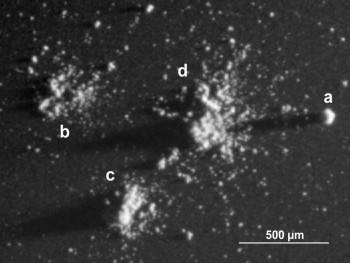
Diversity of particles seen on a small area on one single target. This image section measures 2.5 mm across, with light coming from the right. Examples of a compact particle (a), a shattered cluster (b), a glued cluster (c) and a large rubble pile (d) are seen in this small area.
The grains collected from 11 August 2014 – 3 April 2015 across nine 1 cm^2 targets, when the comet was moving towards the Sun along its orbit from about 3.5 to 2 AU, provide the focus for a detailed study outlined in a paper published this month in the journal Icarus. The paper, led by Yves Langevin of the Institut d’Astrophysique Spatiale at CNRS/University of Paris-Sud, France, describes the key characteristics of the different grain families imaged under the COSIMA microscope, the COSISCOPE.
The images reveal the particles are extremely diverse at scales of just a few 10s of micrometers (μm) to several 100 μm. The grains were characterized according to factors such as the complexity of its appearance and its height above target – determined by analysing its shadow –, which in turn is related to strength of particle.
In general, the dust families can be divided into compact particles or clusters, with the cluster group further subdivided into shattered clusters, glued clusters and rubble piles. The clusters are differentiated based on the different size distributions of the components, their spatial relationship on the collection plate, and the existence or not of any connecting matrix.
The different grain families are described below, including reconstructed anaglyph images made by combining an image at the nominal position (red) and an image obtained by shifting the target by 4mm away from the LED (blue). The particles follow a naming convention based on COSIMA team members and other Rosetta mission team colleagues.
(Note: the credit line for all images is: ESA/Rosetta/MPS for COSIMA Team MPS/CSNSM/UNIBW/TUORLA/IWF/IAS/ESA/BUW/MPE/LPC2E/LCM/FMI/UTU/LISA/UOFC/vH&S/ Langevin et al (2016))
Compact particles
Compact particles are defined as those with well-defined boundaries, more-often-than-not found without any related smaller ‘satellite’ particles. They have the longest and best-defined shadows of all the collected particles, but their direct contact area with the target is often small. Sometimes the grains have been seen to move during analysis, but they still maintained their shape, indicating a high cohesive strength.
Examples of compact particles known as Nick (top), Kerttu (middle) and Julie (bottom). In the images showing Kerttu, the small particle above the scale arrived at a different time to Kerttu, and is therefore unrelated. Both images for Kerttu are anaglyphs taken under different lighting conditions, while for Nick and Julie only the right hand image is an anaglyph.
Clusters
Clustered particles exhibit well-defined sub-components and depending on the size distribution, height and relationship between the components, can be further sub-divided into three sub-classes: shattered, glued and rubble piles.
Shattered clusters
Shattered particle clusters form a close group with no well-defined principal component. The distances between the individual components range from contact to distances in the same range as the size of the components themselves. They likely correspond to rearrangements of components on the target surface upon impact, with less drastic modifications of the components themselves.
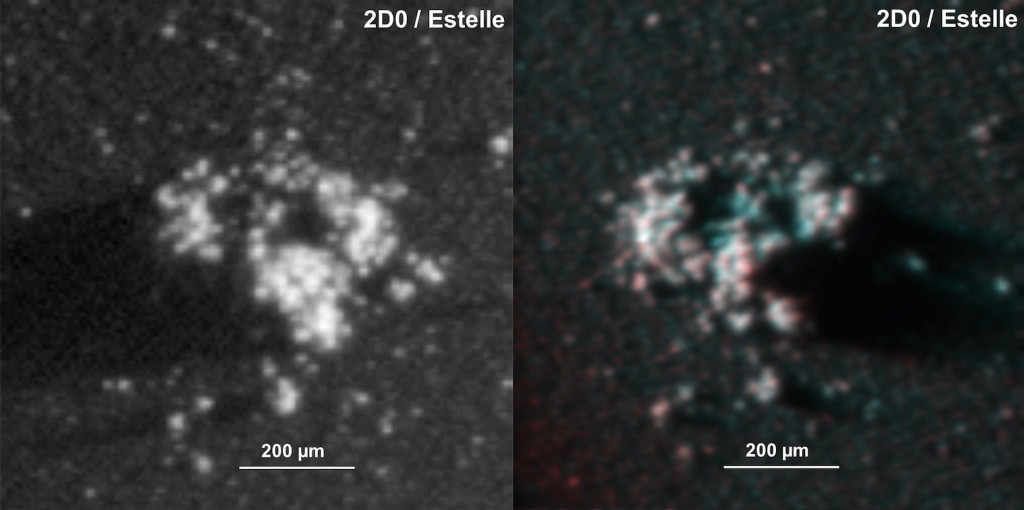
Shattered cluster Estelle, one of the most tightly-packed shattered clusters identified. It has three major components plus many minor components. The right hand image is the 3D anaglyph.
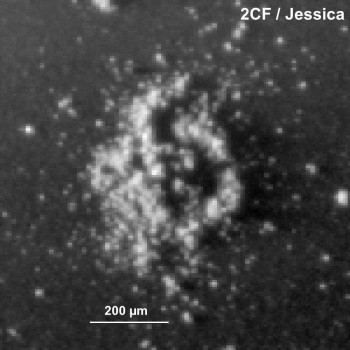
Large cluster Jessica has a complex structure and low height (40 μm), typical of a shattered cluster, but its fine-grained texture and large number of small outliers is typical of ‘rubble pile’ clusters. It is likely intermediate between the two categories.
Glued clusters
Glued clusters comprise relatively well-defined particles with an overall complex structure including sub-components which appear to be linked together by a fine-grained matrix, giving the appearance of a smooth surface texture. Their heights are usually low compared with the base area of the cluster, suggesting that the connecting matrix has not been able to maintain the shape of the particle as it impacted onto the target.
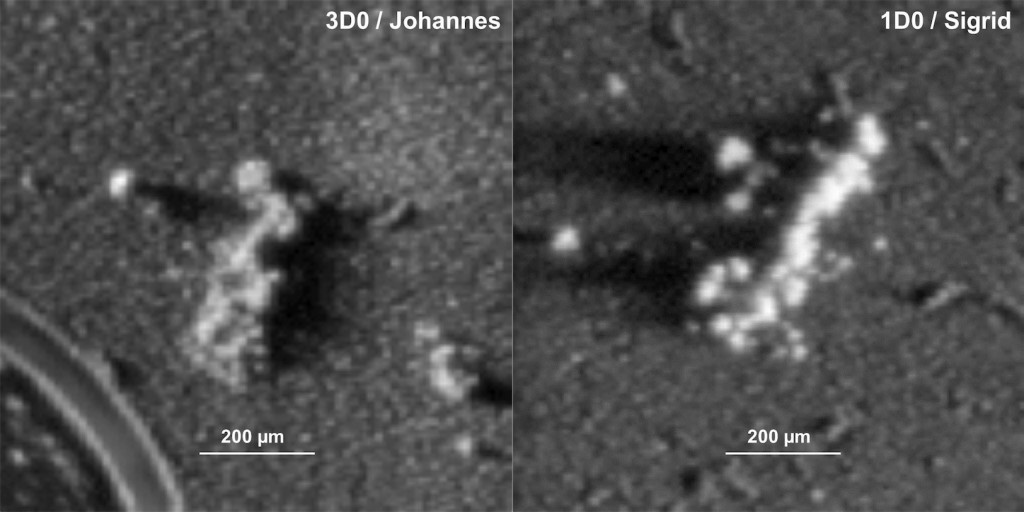
Glued clusters Johannes and Sigrid. They both have a relatively low height compared to their base size, suggesting that the connecting matrix was not able to maintain shape of particle.
Rubble piles
Rubble piles are characterized as clusters composed of very small components. They typically have a flattened conical pile appearance with small outliers indicating that, contrary to glued clusters, the constituents are not strongly connected to a matrix. They are also easily disturbed by the instrument’s ion beam used for targeted analyses.
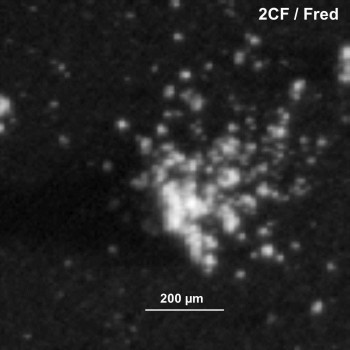
Fred shares characteristics of both glued and rubble pile structures, transitioning from a more consolidated glued cluster in the lower left to a more disperse rubble pile in the top right. It could result from the fragmentation of a large parent particle close to the target, perhaps entering the target at an angle.
Relationships between dust grain families
The COSIMA team also explored any possible correlations between the dates and duration the plates were exposed for and the types of particles collected. For example, the plates are typically exposed for several months, for hours to days at a time, thus the collection period usually covers a wide range of orientations – and sometimes distance – of the spacecraft with respect to the comet and Sun.
As anticipated, the collection rate was highly variable, with a broad and expected trend towards higher collection rates closer to the nucleus. But it is not just comet activity that plays a role in the collection rate; the parent particle grains, over 1 mm in size, are also broken up close to or within the COSIMA collection funnel and target plates, influencing the final morphology of the clusters.
A number of major collection events were also identified, defined as a large number of particles collected in a short period of time. For example, during one day-long collection period on 24 January 2015, 76% of the total volume of grains identified arrived in that one day.
Major collection events include all types of grain types, albeit with different distributions for each event. It is therefore assumed that the clusters share a similar path from the comet surface to Rosetta as compact particles, with a large contribution from mm-sized ‘fluffy’ particles lifted from dust mantle. Some of the more compact particles are thought to originate directly from active regions (as supported by GIADA measurements), while farther from the nucleus they are part of large clusters that fragment close to COSIMA.
At close distances to the Sun (less than 2.35 AU), the compact components constitute more than 30% of the small fragments of parent particles (50 to 100 μm in size), indicating an evolution from mm-sized parent particles dominated by fluffy material to parent particles with more compact small sub-components. This evolution in terms of the components of large parent particles is thought to be linked to the removal of a dust layer dominated by fluffy material beyond 2.35 AU that uncovers cometary layers from which large parent particles with higher mean densities could be released as a result of the higher level of activity of the comet at close distances to the Sun. This also supports the conclusions published by the COSIMA team earlier in the mission.
“Typology of dust particles collected by the COSIMA mass spectrometer in the inner coma of 67P/Churyumov-Gerasimenko” by Y. Langevin et al is published in the journal Icarus.
The individual images are also available at the below links:
Comet dust diversity
Nick, Nick 3D
Kerttu 3D (a) and (b)
Julie, Julie 3D
Estelle, Estelle 3D
Jessica
Johannes
Sigrid
Etienne
Fred
(Reminder: the credit line for all images is: ESA/Rosetta/MPS for COSIMA Team MPS/CSNSM/UNIBW/TUORLA/IWF/IAS/ESA/BUW/MPE/LPC2E/LCM/FMI/UTU/LISA/UOFC/vH&S/ Langevin et al (2016))

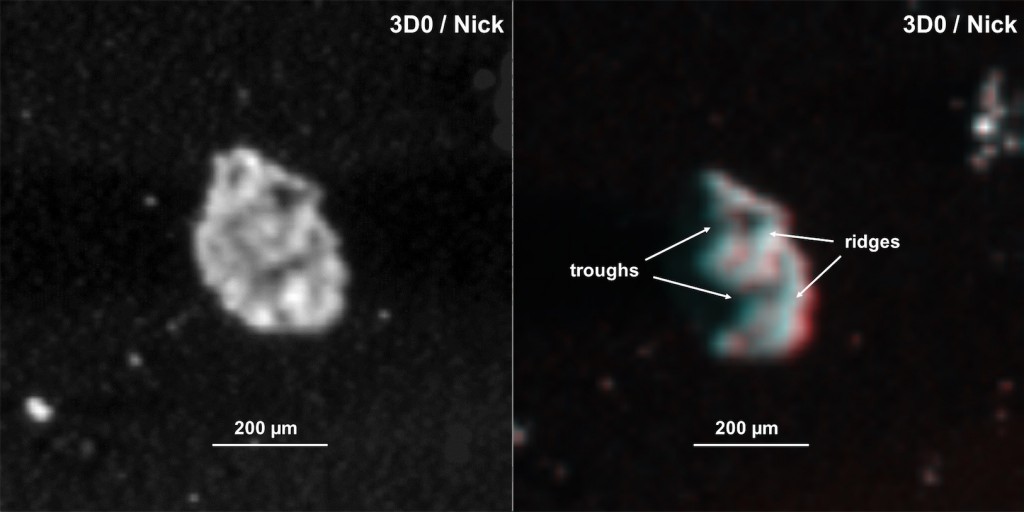
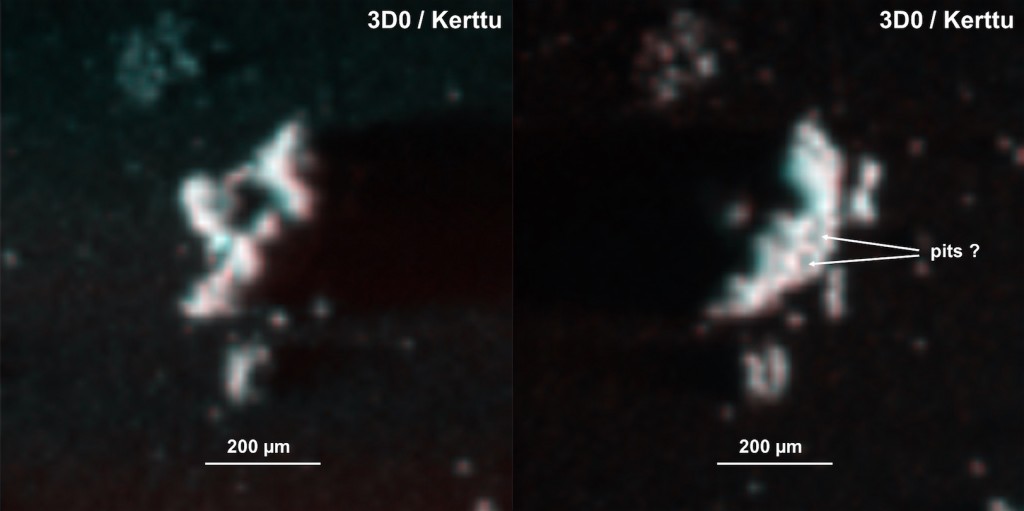
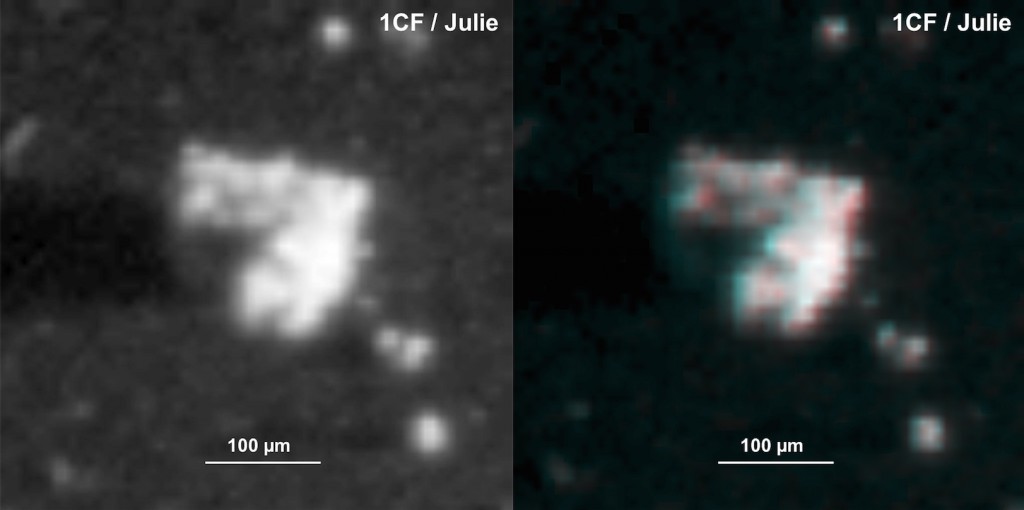
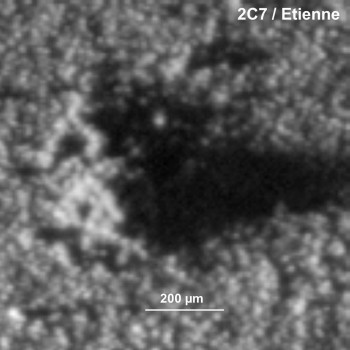








Discussion: 26 comments
Great! Thanks Emily and COSIMA Team.
Forgot one comment:
https://phys.org/news/2016-02-explores-asteroid-deflection-spacecraft-body.html
Most energy efficient is not by altering the kinetic energy of the system. But just altering the geometry of the orbit..
Not Impact-ing, but Yo-yo-ing.
https://en.wikipedia.org/wiki/Yo-yo
Involve a dynamically stringed orbiter Asteroid/Sun Gravities, playing over/under a synchronized orbit.
Hi Emily.
Thanks for your post. I find it interesting that the images of “Nick” and “Kerttu” look like micro sized versions of 67P, all be it their overall shapes are different. All the physical and chemical processes that shape their appearance seem to occur at all scales. Just another demonstration of the fractal nature of the Universe I suppose.
To see “Comet Stuff” up close like this is a quite stunning achievement. Hopefully in due course we will get a good idea of the chemical makeup of these particles too. The conclusions of the team nicely match my own intuitive reasoning and are a great help for us armchair scientists trying to understand this fascinating and crazy place.
Hi Robin,
You write “Hopefully in due course we will get a good idea of the chemical makeup of these particles too”.
It would seem logical to assume that if comets have a shared origin as most of us would presumably agree they do (the fundamental difference between mainstreamers and non-mainstreamers being their wildly diverging conceptions of the *nature* of that origin…), then these dust particles from 67P are highly likely to be made up of broadly the same range of minerals and chemicals as those analyzed in the dust samples which the NASA brought back from the coma of comet Wild 2 in 2006.
For the record (I quote from the Wikipedia article https://en.wikipedia.org/wiki/Stardust_%28spacecraft%29):
“Among the findings are: a wide range of organic compounds, including two that contain biologically usable nitrogen; indigenous aliphatic hydrocarbons with longer chain lengths than those observed in the diffuse interstellar medium; abundant amorphous silicates in addition to crystalline silicates such as olivine and pyroxene, proving consistency with the mixing of Solar System and interstellar matter, previously deduced spectroscopically from ground observations; hydrous silicates and carbonate minerals were found to be absent, suggesting a lack of aqueous processing of the cometary dust; limited pure carbon (CHON) was also found in the samples returned; methylamine and ethylamine was found in the aerogel but was not associated with specific particles. […] In April 2011, scientists from the University of Arizona discovered evidence for the presence of liquid water in Comet Wild 2. They have found iron and copper sulfide minerals that must have formed in the presence of water. The discovery shatters the existing paradigm that comets never get warm enough to melt their icy bulk. ”
It did indeed “shatter the existing paradigm” (just as the discovery of “abundant” molecular oxygen pouring out of 67P has done, again). In addition to the embarrassing “water” connection, scientists working on the “Stardust mission” were also amazed by the discovery of minerals which only form at extremely high temperatures…
David J. Eicher, editor in chief of the “Astronomy” magazine (so presumably a man holding fairly mainstream views on astronomy) writes, in his book “COMETS! Visitors from Deep Space”:
“Astronomers were amazed to find some material from the comet that clearly formed relatively close to the Sun. They discovered grains of a rare mineral, osbornite, titanium nitride, that forms at very high temperatures like 3,000 K. How could material like this, that presumably formed in the early history of the solar system very close to the Sun, be inside a comet that spent most of its life beyond Neptune? The finding suggests that the early solar system was an incredibly violent and dynamically unstable place.”
Yet we now know, since the “finding” of abundant oxygen allegedly locked away homogenously throughout the core of 67P, that the “early solar system” cannot possibly have been “an incredibly violent and dynamically unstable place”, because all available oxygen would have reacted to form other molecules during the process and could hence not possibly be mysteriously locked away inside 67P, (and presumably every other comet).
As I say, there seems to be no logical reason to believe that the dust being ejected from 67P is that different from what was collected from Wild 2, so yet again, Houston, we have a MEGA-problem!
@THOMAS,
” Houston, we have a MEGA-problem!”
Not as many as Thornhill & Talbott have got for their still evidence free electric comet fairy tale! Perhaps they could explain how any of the evidence fits the proposal that this is a piece of rock that was blasted off of a planetary surface by a giant interplanetary lightning bolt!
Typical pseudoscience 101. Try to find any minor ‘problems’ with the current model, whilst blithely ignoring the fact that their own mad idea has been shown to be totally impossible.
And you’re getting a bit confused as to the timing of the formation. The ices, oxygen and many of the organic molecules in comets would have likely formed in the dense interstellar molecular clouds that are the precursors of solar systems. There is no way for them to form close to a star. As the cloud collapses, and the Sun begins to form, material from higher temperature regions will be blown away from the inner disk, to the regions where comets are still in the process of formation.
So not that big a problem. It does exactly what this mission was intended to do; put constraints on the timing, location/s and formation mechanisms for both comets and the solar system.
Are you claiming to have solved the “oxygen” enigma single-handed, Ian? By all means share your theory with us. Instead of going on and on about “Thornhill & Talbott” in your usual knee-jerk reaction style each time I make an impeccably observation-based comment, please just explain how abundant molecular oxygen can be locked up inside comments alongside material that, according to the NASA, formed very close to the sun. You seem to be the only one left in the field claiming to be able to do so, so please go ahead.
No, I didn’t say I’d solved it, but the article on this blog, and elsewhere, shows comments from the authors and others that make the point that certain conditions would need to be in place for the formation of the O2. That, in turn, places constraints on the timing and location of its incorporation into the ices that form comets. None of these constraints fit in with a recent genesis.
As for the Wild 2 grains, nobody is remotely close to suggesting that that means the comet formed close to the Sun! Given the other constituents of comets, that is impossible. There are models of early stellar formation that show the possibility that inner nebula material can be transported to the outer nebula, such as: https://www.aanda.org/articles/aa/full_html/2011/07/aa16476-11/aa16476-11.html
I mention Thornhill & Talbott, and their nutty ideas, merely to put into context, for the unwary, the belief system from which the comments are coming.
I agree that there is a distinct contradiction between the narrative that requires mixing and that requires pristine and very cold accretion.
There is also the evidence that what looks like dust, pebbles, and boulders that have been thought to be ephemeral, are actually just exposed aggregate cemented to the surface. This is a big setback to all theories which call for surface erosion, including EU.
THOMAS,
I acknowledge your attempt to base your post on reliable sources.
However, this attempt has been successful only to some degree, since the statement in Wikipedia “The discovery shatters the existing paradigm that comets never get warm enough to melt their icy bulk” is a citation of an interpretation in a blog post:
https://earthsky.org/space/evidence-for-liquid-water-on-the-surface-of-comet-wild-2#
That’s again a citation from this article:
https://uanews.arizona.edu/story/frozen-comet-had-a-watery-past-ua-scientists-find
referring to this paper:
https://www.sciencedirect.com/science/article/pii/S0016703711001839
“The sulfides in the Wild 2 collection are most likely the products of low-temperature aqueous alteration. They provide evidence of radial mixing of material (e.g. cubanite, troilite) from the inner solar system to the comet-forming region and possible secondary aqueous processing on the cometary body.”
If you read this freely accessible paper, you’ll see that an interpretation of significant large-scale alteration within the comet doesn’t appear very convincing:
“All of the larger than 2 μm silicate phases that have been studied are anhydrous and show no evidence of alteration by aqueous processes. The Wild 2 samples also contain large numbers of submicron anhydrous silicates that would have been modified by contact with water, even for short periods of time.”
(https://onlinelibrary.wiley.com/doi/10.1111/j.1945-5100.2012.01339.x/full)
Only some grains smaller than 2 μm show signatures hinting towards aqueous alterations.
Hence the data say, that contact of silicate grains with liquid water within the comet must have been very short, if at all. Those rare grains might have been altered before comet accretion, as well. The presence of abundant unaltered sub-micron silicate grains rules out the presence of large amounts of liquid water within the comet at any time in its history.
Abundant O2 in 67P, as you state correctly, rules out globally high temperatures in the interior of 67P in its past. So the scenarios for aqueous alterations remain heating by small impacts or early sources from the inner solar system, before comet accretion. This is fully consistent with previous assessments:
“If Wild 2 did not experience large-scale aqueous alteration, but if it does contain bona-fide aqueous alteration products, then these materials could have either formed in local regions of the comet or on other bodies. Local sources could be impact sites where ice melted and produced alteration products. Debris from this material could be spread across the comet by regolith-like processes. If they are produced on other bodies and accreted onto Wild 2, they could be fragments of inner solar materials like carbonaceous chondrite parent bodies or they could also be fragments of substantial size bodies that formed beyond Neptune.”
And don’t forget, that the aqueous alteration results are somewhat fragile:
“A cautionary note here is that the fine-grained material that is most sensitive to alteration was not well preserved by the aerogel capture process.”
(again https://onlinelibrary.wiley.com/doi/10.1111/j.1945-5100.2012.01339.x/full)
Thanks for the detective work and the detailed explanations, Gerald. I’m quite happy to concede the point you’re making.
There remains though the even greater enigma of materials like titanium nitride (“osbornite”) which apparently only forms at temperatures of around 3,000 K. I see this as the major problem for the standard theory in terms of the seemingly impossible cohabitation of such material in comet nuclei with the recently revealed abundance of molecular oxygen.
Thomas, grains forming in a high temperature environment cooled down, before accreting to the comet.
Osbornite is stable at low temperatures. It can coexist with frozen O2.
I don’t see the enigma.
Hi Gerald,
This is not an expectation for accretion disks. CAI’s are a case in point. In their formation radioactive aluminium generates heat for millions of years.
Sure, you can say it’s possible, but it makes no sense that it should be just so.
Hi Marco,
the dynamics of a collapsing cold interstellar dust and gas cloud doesn’t need to be trivial.
Friction takes time to form a planar disc, sufficiently calm to allow for comet accretion.
Radioactive aluminium starts to decay after it’s formed. That’s not necessariy incident with solar system formation, but e.g. with supernova explosions, or with cosmic ray irradiation.
Small grains don’t heat up much by the radiogenic heat. 7 million years after formation of Al-26, only 1/1000-th of its initial abundance is left over, if formed by a supernova.
When formed by cosmic ray irradiation, the decay product Mg-26 can accumulate over time without ever needing high abundance of Al-26.
The radiogenic heat by Al-26 can hence easily be low at the time comets form from small grains, despite an Mg-26 signature being present.
https://en.wikipedia.org/wiki/Aluminium-26
https://www.psrd.hawaii.edu/Sept02/PSRD-Al26clock.pdf
Hi Gerald,
That is a rather convoluted “accretion” process that no longer appears to be anything like the conditions we see in observed accretion disks. The process you describe so separates the formation of minerals to their coming together, that one could feasibly think of a way it could have happened 4 million years ago rather than 4 billion. A seed asteroid could travel through a heterogenous molecular cloud, accreting as it travels through. Molecular clouds are virtually invisible and many should be hanging around the galactic plane, giving ample opportunity for a small asteroid to accrete a mixture of volatiles and other materials over the time frame of tens of millions of years ago, thus meaning the materials in and emanating from comets have little relevance to the early solar system.
Hi Maro,
see subsection 3.1 of this lecture about the Jeans instability to get a rough idea about the early virulent phase of a collapsing (initially) cold molecular cloud.
https://www.mpia.de/homes/mordasini/slidesws1123/L3starformation2.pdf
About the composition:
https://en.wikipedia.org/wiki/List_of_interstellar_and_circumstellar_molecules
About gas-grain chemistry in cold interstellar clouds:
https://arxiv.org/pdf/1209.5733v1.pdf
Small dark, and dense interstellar clouds as likely star-formation regions:
https://en.wikipedia.org/wiki/Bok_globule
Since they are no perfect spheres, they collapse asymmetrically, fragment, and need time to form a symmetrical protoplanetary disk around respective protostars.
So, yes, formation of the grains, and accretion to larger body can well be different.
Some grains form immediately near old stars, before the material is added to the interstellar medium.
… molecular clouds are well-observable, since they occlude (the light of) background stars.
The local fuff (https://en.wikipedia.org/wiki/Local_Interstellar_Cloud) is too hot and too dilute to be able to condense to grains.
Currently, only very few interstellar dust is travelling through our solar system:
https://arxiv.org/abs/1510.06180
Hi Thomas
Good to hear from you again. I would certainly be surprised if the chemical nature of these particles is too much different from comet Wild 2. What also may be missing from this discussion is that the material that made up the pre solar nebula was itself recycled material from many previous stellar evolutions. A grain of a particular mineral could have been “made” in any number of unknown circumstances and finally ended up captured at random in a comet wherever it formed within our solar system. I know that is not much help really, but since it is difficult for any theory to be proved when the baseline starting conditions are so vaguely defined it is not surprising so many “arm waving” theories abound. Indeed it is because of this that the mission to 67P is so important to try and get a better understanding of pre solar nebula constituents.
Hi Robin,
I’m interested above all in understanding how the mainstream theory can attempt to simultaneously accommodate these prior findings on the one hand, with all the violence and turmoil they necessarily imply in the hypothesized formation-processes of the solar system and, on the other hand, the totally unexpected discovery of abundant molecular oxygen allegedly somehow locked up throughout comet nuclei.
The simplest ad-hoc approach would be assuming H2O2-enriched H2O ice, instead of pure H2O. H2O ice enriched in H2O2 may decay into H2O and O2 over time.
H2O2 forms e.g., when UV of sunlight shines onto snow in winter, in the presence of atmospheric oxygen. An excess of oxygen would be needed for this scenario, after water formed and cooled down
https://en.wikipedia.org/wiki/Peroxide#Hydrogen_peroxide
Related are superoxides:
https://en.wikipedia.org/wiki/Superoxide.
Another mechanism would be Marco’s decay of Al-26 into Mg-26:
One Al atom binds three oxygen atoms, while Mg binds just two oxygen atoms.
Aluminium-26, e.g. as Al2O3, would decay into 2 MgO2 + O2.
In the presence of H2O ice, the O2 would be trapped in the ice.
Sorry, MgO, not MgO2.
… two Al-atoms bind three O-atoms;
two Mg-atoms bind two O-atoms.
… I should have a break after a 24-hours day.
CHIMERA goes on to the Hale 🙂
Really exited about the possibilities of this high speed, difractive dynamics technology.
Wishing the best for the involved Teams..
https://phys.org/news/2016-03-versatile-instrument-scout-kuiper-belt.html
Long due tread in this beautiful ESA Out-Reach Blog:
“What we hope will follow is a broad discussion across the scientific community that leads to a more nuanced approach to interpreting, communicating, and using the results of statistical methods in research.”
American Statistical Association.
https://phys.org/news/2016-03-american-statistical-association-statement-significance.html
https://www.tandfonline.com/doi/pdf/10.1080/00031305.2016.1154108
A couple of intersting tweets from the ESLAB conference that might interest people:
**Vincent: Before 2.5 AU (jets) start in the morning and fade at night. After 2.5 AU jets remain active beyond evening terminator.**
**Engrand: 26Al depleted by time of comet mineral formation. Inner solar system matter transported outward.**
Can be followed at: https://twitter.com/Philae_MUPUS
Re MUPUS.
Thanks Ian, some interesting stuff but not so easy to follow as usual with twitter.
regards
Thanks, IanW and Philae_MUPUS, for the tweets